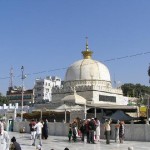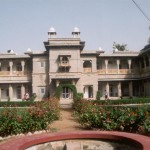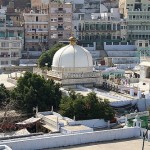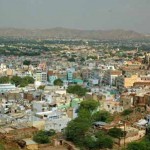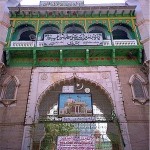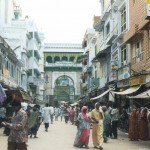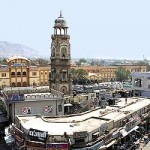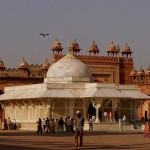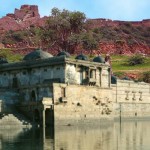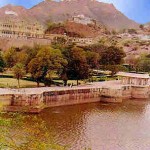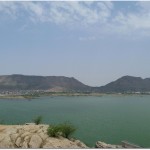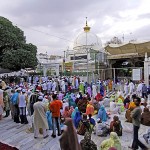Ajmer, formerly written Ajmere, is a city in Ajmer District in India’s Rajasthan state. Surrounded by the Aravalli Mountains once ruled by Prithviraj Chauhan. Ajmer always had great importance and was sacked by Mahumud of Ghazni on one of his periodic forays from Afghanistan. Later it became a favorite residence of the great Moghula. One of the first contacts between the Moghula and the British occurred in Ajmer when Sir Thomas Roe met with Jahangir here in 1616. The city was subsequently taken by the Scindias and, in 1818, it was handed over to the British, becoming one of the few places in Rajasthan controlled directly by British rather than being part of a princely state. Today, Ajmer is a popular pilgrimage centre for the Hindus as well as Muslims. Especially famous is the Dargah Sharif-Tomb of the Sufi Saint Khwaja Moinuddin Chisti, which is equally revered by the Hindus and Muslims. Ajmer is a centre of culture and education. The British chose Ajmer for its prestigious Mayo College, a school exclusively for Indian nobility. Ajmer is also the base for visiting Pushkar (11 km.). Architectural monuments in the city include an ancient Jain temple (converted c. 1200 into a mosque); the white marble tomb complex of the Muslim saint Muin-ud-Din Chishti (d. 1236); and the palace of Akbar (reigned 1556-1605), now a museum. The city was a Muslim military base used in operations against the Rajputs.
Geography
It is situated in 26° 27, N. lat. and 74° 44, E. long., on the lower slopes of Taragarh Hill. It is situated almost in the heart of the state of Rajasthan. To the north of the city is a large artificial lake, called Anasagar, adorned with a marble structure called Baradari. Ajmer is an ancient crowded city with modern developments in the outskirts.
Urs Ajmer Sharif
Held in the memory of the revered Sufi saint Khawaja Moinuddin Chishti, it is an occasion for thousands of believers to congregate at the shrine and offer their prayers. All of Ajmer seems to take on a festive air and several programs are organized to mark the festivals.
Weather
In Summer: 45 C (Max) – 25 C (Min)
In winter: 18 C (Max) – 4C (Min)
Rainy Season : July to Mid Sept, and very humid (up to 90%)
Our suggestion: Best time to come: Oct to March
Places to see in Ajmer
Taragarh
Taragarhor the ‘Star Fort’ is situated three kilometers and a steep 1 and a half hour climb beyond the Adhai-Din-Ka-Jhonpra Mosque. As it is situated on a height, it commands a spectacular view over the city. It was built by Ajaipal Chauhan, the town’s founder.
Shah Jahan Mosque
In the corner of the inner court of the Dargah, is a magnificent building in white marble with a long (30.5m) and narrow court having low arcade and delicate carvings with trelliswork it is the most marvelous of all the sanctums within the sanctuary of the Dargah.
Pushkar Lake
This lake is situated at the edge of the desert and surrounded by the hills from three sides. This lake get apart from Ajmer by the snake mountain range called locally as ‘ Nag Parvat’.
According to the legend Pushkar was originated when lord Bhramha was looking for a peaceful place for ‘Yagya’. It is said that a Lotus flower slipped from his hand and fell down on this hill, where the Pushkar Lake derived. Therefore the Bhramha temple situated here, is a famous pilgrimage for Hindus.
On this mountain, the Panchkund and the cave of the saint Agastya are located.
Nasiya Temple
Situated in the center of the town is a beautiful red Jain temple (Digambar), known as Nasiyan. This temple was built in 1865 and is also famous by the name Golden Temple, due to tis amazing and unique display. The main double storeyed hall is exceptionally beautiful with gold and silver decorations. Within the temple there is a splendid display of wooden gilt representations, glass engravings and paintings describing the Jain faith about the creation of the world.
Mayo College
It is a school that was designed to make British gentlemen out of Indian princes.
Man Mahal
Along the banks of the Pushkar Lake is the former residence of Raja Man Singh of Amer, Man Mahal. Foy Sagar
Foy Sagar is a picturesque artificial lake named after the engineer for who created it under a famine relief project.
Dargah Sharif
Situated at the foot of a hill and in the old part of town, this is one of the most important places in india for muslim pilgrims. The Dargah is the tomb of a Suffi saint, Khwaja Muin-ud-din Chishti, who came to Ajmer from Persia in 1192 and died here in 1236. Construction of this shrine was completed by Humayun and the gate was added by the Nizam of Hyderabad. Akhbar used to make the pilgrimage to the Dargah from Agra once a year.
As you enter the courtyard, the mosque, constructed by Akhbar, is on the right. The enormous cauldrons are for offerings that are customarily shared by families involved in the shrine’s upkeep. In the inner court there is another mosque built by Shah Jahan. Constructed of white marble, it has 11 arches and a Persian inscription running the full length of the building.
The saint’s tomb is in the center of the second court. It has a marble dome and actual tomb inside is surrounded by a silver platform. The horse shoes nail to the shrine doors are offerings from successful horse dealers.
This shrine is a hive of activity and you can really get a sense of how deeply significant it is to the Muslim people.
Ana Sagar Lake
This artificial lake was created by damming the river Luni.On its bank are the fine parks, the Dault Bagh and Subhash Bagh, with a series of marble pavilions that were erected in 1637 by Emperor Shah Jahan. There is an island in the center of the lake which is accessible by boats or water scooter.
Akbar Palace
Back in the city, near the railway station, this fort was built by Akbar in 1570 and today houses the Ajmer Museum
Adhai Din Ka Jhonpda
Beyond the Dargah, on the outskirts of town, are the ruins of Adhai-Din-Ka-Jhonpra mosque. According to legend its construction, in 1153, took just 2 and a 1/2 days. (Adhai-Din-Ka-Jhonpra means ‘2 and a 1/2 day building’).
Facts about Ajmer
Location: Southwest of Jaipur.
Distance: Bharatpur (305 km), Jodhpur (210 km), Udaipur (303 km), Kota (200 km)
STD Code: 0145
Population: .49 millions
Area: 9.8 sq km.
Language: Hindi & Rajasthani
Altitude: 413 meters
Clothing: Summer light tropical (cotton) for summer & Light woolen for winter
Useful Information:
Nearest Airport : Jaipur
Tourist Reception Centre : RTDC Hotel Khadim, Savitri College Road.
Tel No. :
+91-145-2627426
+91-145-2621364
Important Tel Nos.
Tourist Information 2627426/1364
RTDC Hotels 2627490
Govt. Museum 2620637
Ajmer Club 2627003
P. R. O. 2625842
Railway Enquiry 130,131,2432535
Railways Reservation 2431965
Bus Reservations 2629398
Police 100
Ambulance 102
CID 2620971
Circuit House 2425795
General Post Office 2431656
Submit your review | |
